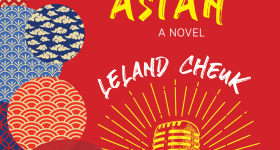One of the first characters readers are introduced to in Jon Pineda’s new imagery-rich novel, Let’s No One Get Hurt, is the river that curls itself around the compound where young protagonist Pearl and her ragtag group of compadres lives. Pineda compares the river at times to “tailor’s chalk” and at other times to “television static.” But the most precise description of the river — and the role it plays for Pearl in her winding path toward womanhood — is the virgule, “meaning ‘either this or that.’ Or both, fusing like a stitch.”
Or, more eloquently put in the precocious 15-year-old’s words: “Whenever I see a virgule wedged between two words, I think of it as being between two worlds, separating one side from the other. The river is a virgule.”
It’s no wonder then, that Pearl spends so much time in the river. She is, after all, exploring the jagged boundaries between childhood innocence and full-fledged womanhood, the reality of the poverty she lives in and the fantasy of a pristine, privileged life she can only pretend to be a part of. In Let’s No One Get Hurt, Pearl resides with her father, a former college professor-turned-artist; Dox, a sweet-tempered friend of her father’s with a knack for sewing; and Fritter, Dox’s towering son, known for his incomparable singing voice and resilient strength, in an overgrown lot right off a critter-rich river in the Deep South. The foursome live on what Pearl’s father refers to as “borrowed” land; Pearl prefers to call it what it is — squatting.
The story is a coming-of-age tale set against a dense backdrop of loss, abandonment and crumbling facades. Pearl is 15 going on 16, but in her own words, “hasn’t started” yet. She is struggling to come into her own with a father who prefers the illusion of the bottle to reality and a mother who absented herself from their lives some years ago. When Pearl one day comes into contact with Main Boy, a rich boy whose father owns the land where Pearl and the others are squatting, things begin to change, with this new reality tempting her into an unfamiliar world of wealth that both intrigues and disgusts her. Main Boy and his group of friends (or flies, as she likes to call them) ride around in golf carts and indulge in excess, relying on their parents’ money and privilege to cushion their own paths toward adulthood. Meanwhile, Pearl and the men scavenge and fish for food, oftentimes having to go without.
“Other days there’s simply no food,” Pearl explains. “I’ve found you can eat the silence that grows inside a house. It gets so quiet I can hear everyone barely breathing, and that’s a feast, for sure.”
In addition to straddling two socioeconomic realities, Pearl is also learning some of the more painful truths about the roles that abandonment and loss play in the process of becoming a woman. A big theme that threads itself through the novel is that of absence, and what or who we seek in order to fill the void of sound, of compassion, of intimacy. Pearl’s mother echoed this theme while she was around to instruct her daughter, often telling Pearl that poems were never finished but abandoned. Pearl, in her young wisdom, thought of how poetry and abandonment might relate in another way: “I like to take some things my mother said and flip them on their head. For instance, I think all abandoned things are poems. In this way, if this place where we live together is truly abandoned, then we are living inside a poem.”
And indeed, the muggy heat of the South where Pineda’s novel takes place is clearly poetic in both form and insight — the characters are living inside a poem. The novel’s sensual language and exquisitely selected words are noticeably poetic (Pineda is, in addition to being both a novelist and a memoirist, a prolific poet). His chapters are often quite short, with admirably sculpted paragraphs and last lines that cause the reader to double-back and reread the words again with fresh insight, much as one might read and reread a stanza within a poem. The world Pineda has created for Pearl equates poetry to the practice of abandonment. However, Pineda at times runs in the opposite direction, emphasizing what is present, what is not lost, in as vivid and as palpable a way as possible, so that her losses are more acutely felt later on.
Let’s No One Get Hurt is achingly beautiful in its delivery and in the ways in which Pineda allows Pearl, like poetry, to be as complex and as nuanced as she wants to be. Though the simplest way to describe the book is as a coming-of-age story, it really is a story of discovery, of understanding the world and the infinite number of things that Pearl and readers will never be able to fully access. The story is ultimately about the facade that words create on a page, of what we presume to be the world as we know it. But the point at which it deliciously begins to fall apart in Pineda’s prose is the part where the novel really begins to take flight.
At one point in the book, Pearl sprints across a grassy field with full abandon, and in her movements, she finds an answer to a riddle she likely hadn’t known she’d been trying to solve.
“I sprint beyond being a girl in my own body.
I become an idea.
I know I’m not a woman yet.
But I’m also not a girl.
I’m a poem no one will ever translate.”
The river may be a virgule, but in many senses, so is Pearl herself. She’s always “either this or that.” Or “both, fusing like a stitch.”









Comments